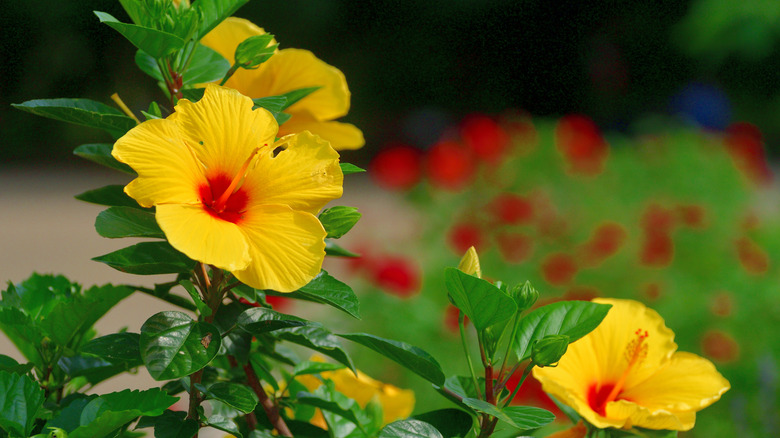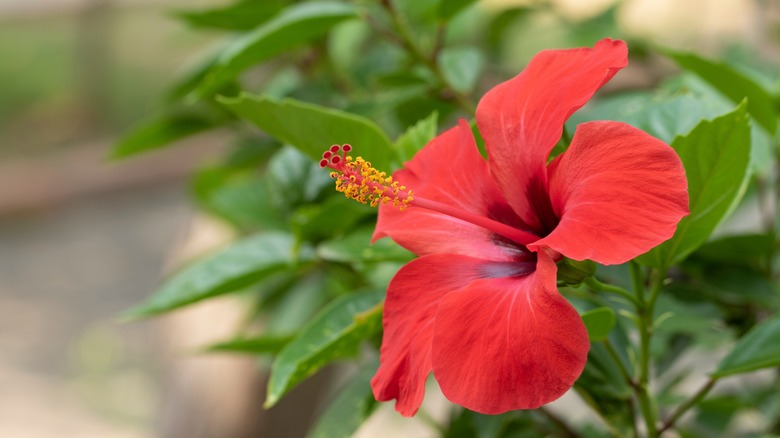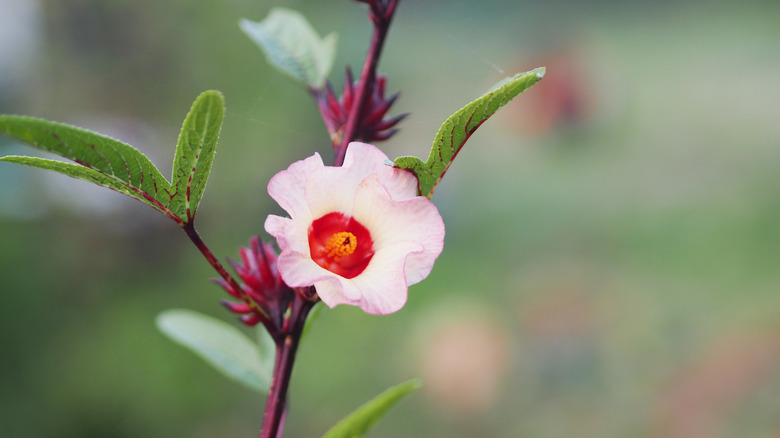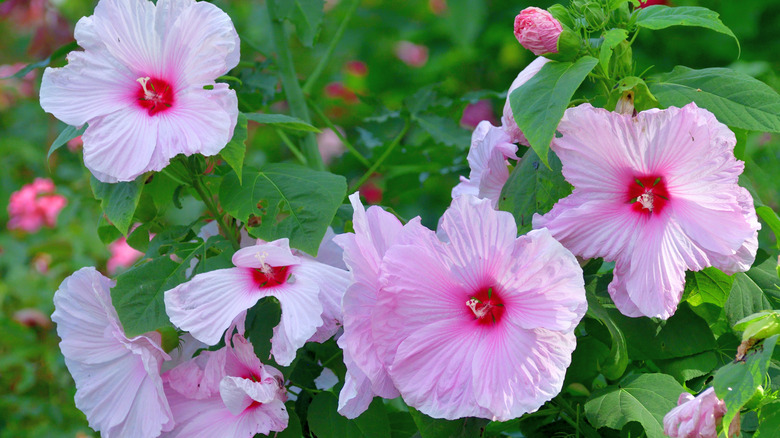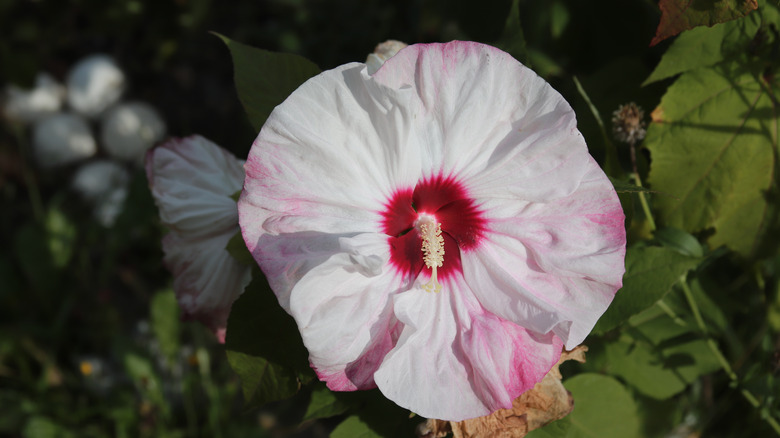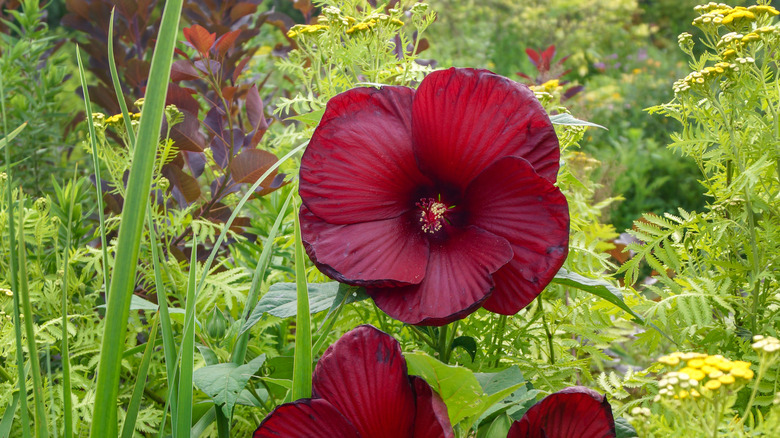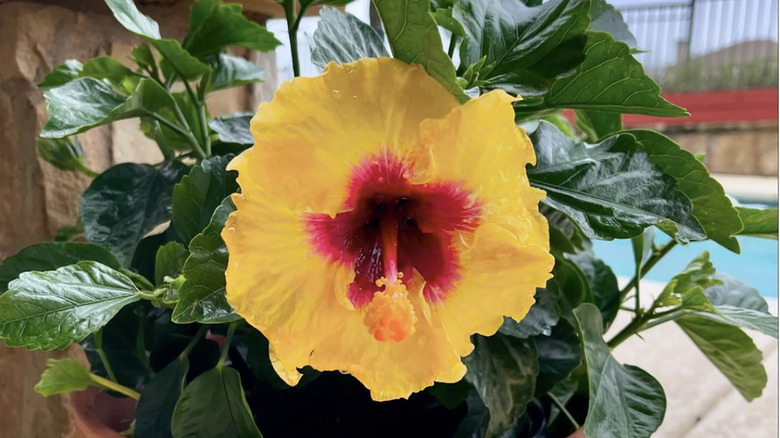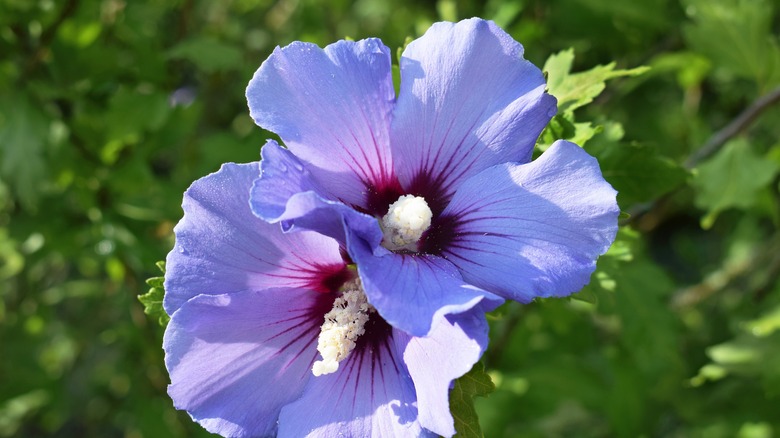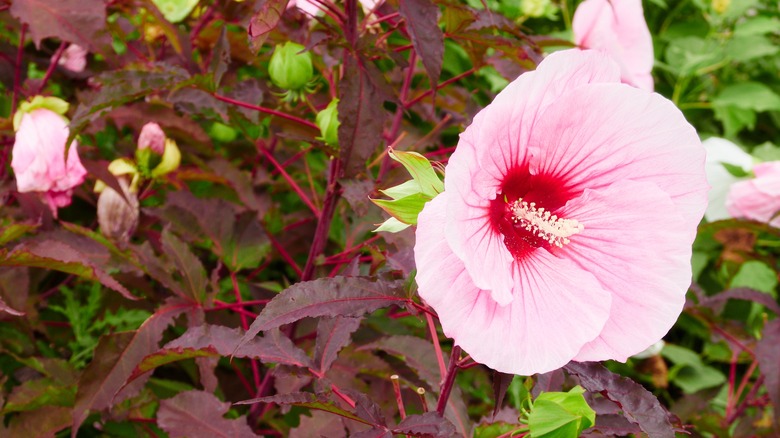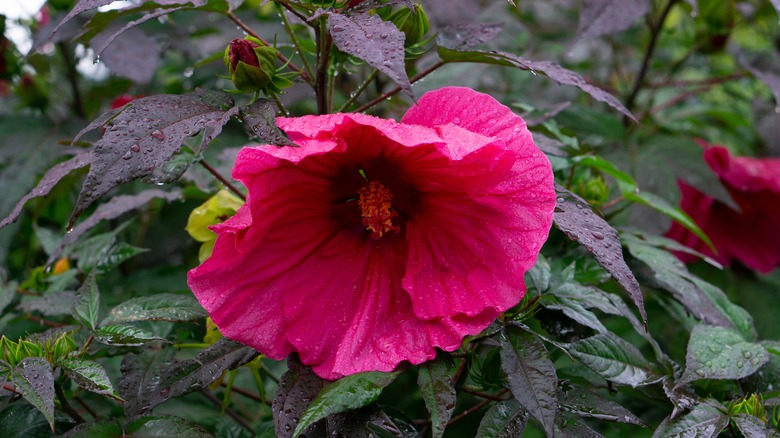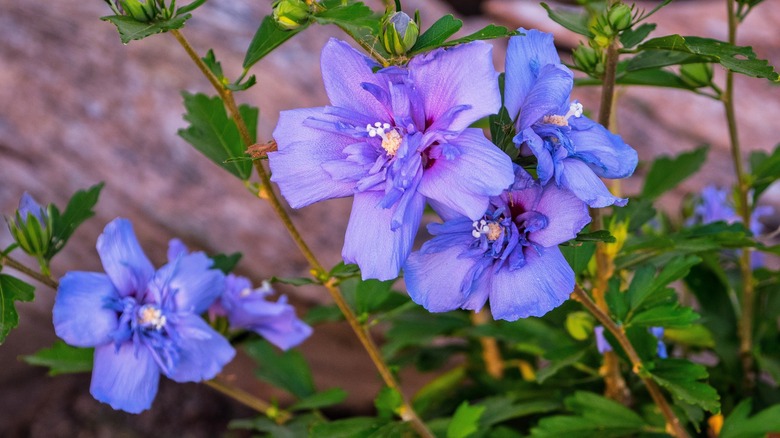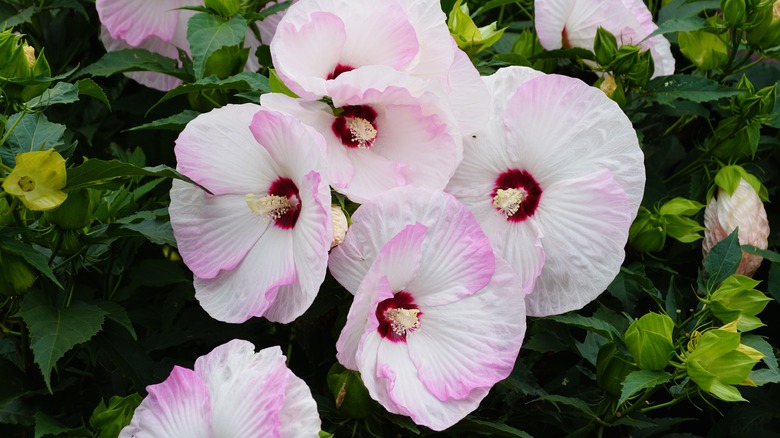11 Colorful Varieties Of Hibiscus Flowers For A Tropical Garden That Stands Out
Whether you're creating a garden paradise around your pool area or want a tropical vibe surrounding your patio for entertaining friends and family, there are many different hues of hibiscus ranging from subtle to vivid that can help you achieve your gardening goals. The varieties you choose can depend on whether you want to focus on container plants or use them for landscaping. Do you want traditional-looking hibiscus blooms or giant-sized flowers that will wow your guests? You'll also have to consider where you live when deciding what to plant.
For example, tropical hibiscus (Hibiscus rosa-sinensis) varieties are better suited for landscaping in warm climates whereas perennial or hardy hibiscus (Hibiscus moscheutos) can be planted in beds much further north in the United States. Hybrids of hardy hibiscus can offer much larger blooms, but some extraordinary color combinations fall into the tropical category. There are also some variations of bushier hibiscus plants known as rose of Sharon (Hibiscus syriacus) that offer beautiful blue blooms, so you definitely have lots of choices. Learning about the different varieties of hibiscus flowers before planting them can help you select the right ones to create the amazing tropical garden you're envisioning.
1. Tropical hibiscus
Tropical hibiscus (Hibiscus rosa-sinensis), also called Hawaiian hibiscus or Chinese hibiscus, most often has red, yellow, pink, or orange blooms that usually last just a single day. Their flowers are eye-catching, though, so that makes up for the short lifespan. They work well in containers so you can move them around, but can be planted in beds in zones 9 to 12. They like lots of sunlight and will put on larger blooms in greater abundance if you meet that need. They also thrive with even moisture, so they require watering frequently as the summer heats up.
2. Roselle hibiscus
Roselle (Hibiscus sabdariffa) has several other names including sorrel and Florida cranberry (even though it's part of the mallow family). If you've enjoyed hibiscus tea, in fact, it was likely made from parts of roselle flowers left behind after the blooms faded. This relative of okra can be grown in zones 8 through 11 as a herbaceous perennial but in zones 3 through 7 it is a fast-maturing annual. For it to bloom, it needs at least 12 hours in the dark. In addition to producing attractive flowers, it has eye-catching red stems and leaves with red veins to brighten a garden.
3. Hardy hibiscus
Hardy hibiscus (Hibiscus moscheutos) has many different names including common rose mallow, swamp mallow, and marshmallow hibiscus. Given all the leading references, it's no surprise that it's part of the Malvaceae, or mallow, plant family and gummy roots from those types of plants were actually used to make marshmallow candy in ancient times. Hardy hibiscus blooms are large measuring up to 8 inches across (and several hybrids grow even larger). Hardy in zones 4 through 9, these perennials grow from 2 to 6 feet tall in full sun and bloom from the summer months through early fall.
4. 'Cherry Cheesecake' hibiscus
This hybrid hardy hibiscus (Hibiscus moscheutos 'Cherry Cheesecake') is a herbaceous perennial producing white blooms with purple-pink veins and a deep reddish-pink center. It grows well in zones 4 through 9 with early to late spring being the best time of year to plant this gorgeous hibiscus. Plan on giving this pretty flowering plant full sun and keeping the soil moist to see blooms from July through September. Deer aren't attracted to it but butterflies are, so that's a tick in the plus column when considering 'Cherry Cheesecake' as an addition to a garden.
5. 'Heartthrob' hibiscus
Another hybrid hardy hibiscus (Hibiscus moscheutos 'Heartthrob'), this perennial also known as 'Heartthrob' rose mallow offers growers dark red blooms that can add a moody vibe to a garden. The flowers on this hibiscus are quite a bit larger than average, too, reaching 8 to 10 inches across so they can really put on a show, even from a distance. These eye-catchers grow well in full sun or partial shade in beds and as border plants. Expect 'Heartthrob' to bloom beautifully from July through October in zones 4 through 9. This is winner for attracting hummingbirds, too.
6. 'Rico Suave' hibiscus
This tropical hibiscus (Hibiscus rosa-sinensis 'Rico Suave') is one of a number of unique hybridized color variations marketed under the brand name Hollywood Hibiscus®. The vibrant hues of 'Rico Suave” offer an eye-catching combination of bright yellow petals with deep red centers to a garden. They're hardy in zones 9 through 11 when used as landscaping plants but also thrive in containers so you can take this tropical hibiscus inside for the winter. These plants flower fervently with lots of sunlight and can withstand summer heat in warm climates.
7. 'Blue Bird' hibiscus
'Blue Bird' rose of Sharon (Hibiscus syriacus 'Blue Bird') is a bushy plant from the mallow family well-suited for hedge use in zones 5 through 9. Since it grows 8 to 12 feet tall and about 6 to 10 feet across, be sure to plant this one where it has room to spread out. It will grow in partial shade but does its best blooming in full sun. Unlike rose of Sharon (Hibiscus syriacus), which is invasive in some states, this is a sterile cultivar so it does not produce seeds while yielding lovely blue blooms.
8. 'Perfect Storm' hibiscus
If you're looking for a pretty pink hardy hibiscus (Hibiscus moscheutos 'Perfect Storm'), this one with a bold red center makes a striking choice. 'Perfect Storm' is a hybrid herbaceous perennial that tops out at about 3 feet tall. It boasts large blooms measuring 6 to 10 inches throughout the summer in zones 4 through 9 and is winter hardy in zones 4 or 5. Known as a relatively low maintenance plant, it grows well in a variety of soils as long as they're kept on the wet side. The more sun the better for abundant blooms.
9. 'Cranberry Crush' hibiscus
This is another variety of hardy hibiscus (hibiscus moscheutos 'Cranberry Crush') offering lovely, ruffled blooms with vivid scarlet coloring to brighten a garden space. These perennials thrive in zones 4 through 9 and you can expect abundant blooms from July through September. Even though 'Cranberry Crush' likes minimal shade and lots of sunlight each day during blooming season, it prefers moderately moist to wet soil. The color of this hardy hibiscus hybrid makes a great addition to a space with a tropical vibe and the showy red blooms also attract butterflies as a bonus.
10. 'Blue Chiffon' hibiscus
This variety of rose of Sharon (Hibiscus syriacus 'Blue Chiffon') provides gardeners with blooms differing from the look of a traditional hibiscus. "Blue Chiffon' has an additional row of petals that impart a frilly appearance and enhance the beautiful blue coloring. These tall shrubs, hardy in zones 5 through 9, bloom all summer long. They have the advantage of being heat and drought tolerant and do well in full sun or partial sun as long as they get at least 6 hours daily. They're not picky about soil, but don't like super dry or very wet conditions.
11. 'Luna Pink Swirl' hibiscus
For another hardy hibiscus Hibiscus moscheutos 'Luna Pink Swirl') choice with a pretty rose hue in the in the blooms, this is a lovely alternative. 'Luna Pink Swirl' grows best in zones 5 through 9 and reaches a height of about 3 feet tall. The white flowers with pink edges and a bright red center bloom voraciously from July through September. Like other hardy hibiscus hybrids, 'Luna Pink Swirl' requires full sun and moist soil to put on its best show of large 4- to 6-inch blooms for you.
